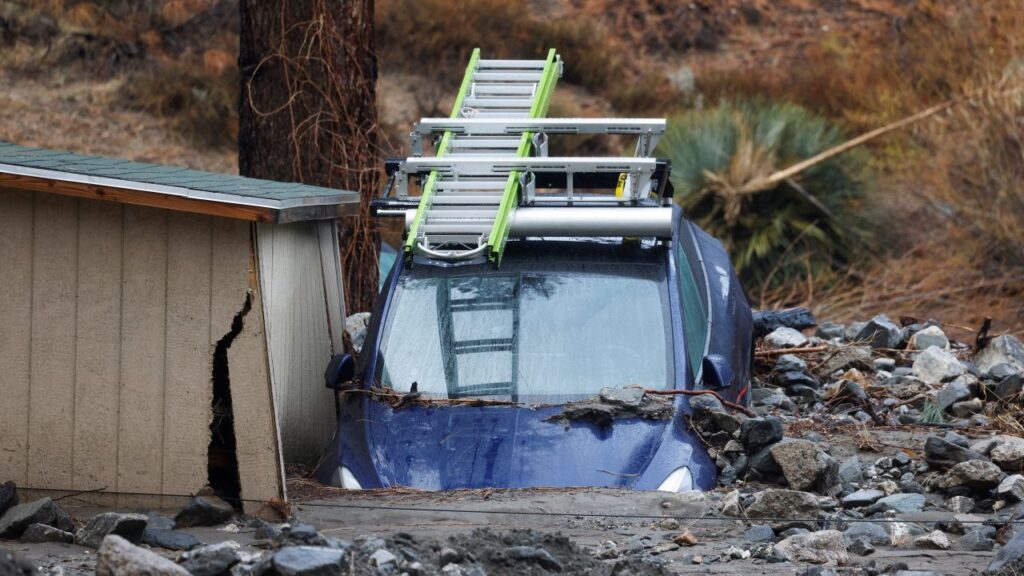Share
KIRUNA, Sweden — Thick reindeer fur boots and a fur hat covering most of his face shielded Niila Inga from freezing winds as he raced his snowmobile up to a mountain top overlooking his reindeer in the Swedish arctic.
But Inga is troubled: His reindeer are hungry, and he can do little about it. Climate change is altering weather patterns here and affecting the herd’s food supply.
“If we don’t find better areas for them where they can graze and find food, then the reindeers will starve to death,” he said.
Already pressured by the mining and forestry industry, and other development that encroach on grazing land, Sami herding communities fear climate change could mean the end of their traditional lifestyle.
Slipping his hand from a massive reindeer skin mitten, Inga illustrated the problem, plunging his hand into the crusted snow and pulling out a hard piece of ice close to the soil.
Unusually early snowfall in autumn was followed by rain that froze, trapping food under a thick layer of ice. Unable to eat, the hungry animals have scattered from their traditional migration routes in search of new grazing grounds.
The Arctic Is Warming Twice as Fast as the Rest of the Globe
Half the herd carried on east as planned, while the rest retreated to the mountains where predators abound, and the risk of avalanches is great.
Elder Sami herders recall that they once had bad winters every decade or so, but Inga said that “extreme and strange weather are getting more and more normal, it happens several times a year.”
The arctic is warming twice as fast as the rest of the globe. Measurements by the Swedish Meteorological and Hydrological Institute show the country has warmed 1.64 degrees Celsius (2.95-degree Fahrenheit) compared with pre-industrial times. In Sweden’s alpine region, this increase is even greater, with average winter temperatures between 1991 and 2017 up more than 3 degrees Celsius (5.4-degree Fahrenheit) compared with the 1961-1990 average.
Snowfall is common in these areas, but as temperatures increase, occasional rainfall occurs — and ‘rain-on-snow’ events are having devastating effects. The food is still there, but the reindeer can’t reach it. The animals grow weaker and females sometimes abort their calves while the survivors struggle to make it through the winter.
“We have winter here for eight months a year and when it starts in October with bad grazing conditions it won’t get any better,” Inga said.
That is devastating to Sami herders, a once-nomadic people scattered across a region that spans the far north of Sweden, Norway, Finland and the northwestern corner of Russia. Until the 1960s, this indigenous minority were discouraged from reindeer herding and their language and culture were suppressed. Today, of the 70,000 Sami, only about 10% herd reindeer, making a limited income from meat, hides and antlers crafted into knife handles.

Herders Have Started Working With Stockholm University
“Everyone wants to take the reindeers’ area where they find food. But with climate change, we need more flexibility to move around,” said Sanna Vannar, a young herder from a community living in the mountains surrounding Jokkmokk, an important Sami town just north of the Arctic Circle. “Here you can’t find food, but maybe you can find food there, but there they want to clear-cut the forest and that’s the problem.”
“We’ve said we don’t want money because we can’t buy better weather with money,” Vannar said. “We’ve said we need that the EU take action and they need to do it now.”
The EU’s new executive Commission is expected to present a ‘European Green Deal’ on Wednesday, to coincide with a U.N. climate conference in Madrid.
Herders have also started working with Stockholm University, hoping to advance research that will broaden understanding about changing weather patterns.
As part of this rare collaboration between Sami and science, weather stations deep in the forests of the Laevas community are recording air and ground temperature, rainfall, wind speed and snowfall density. Sami ancestral knowledge of the land and the climate complements analysis of data gathered, offering a more detailed understanding of weather events.
Rosqvist Hopes This Research Can Help Sami Communities
“With this data we can connect my traditional knowledge and I see what the effects of it are,” says Inga who has been working on the project since 2013 and has co-authored published scientific papers with Ninis Rosqvist, a professor of Natural Geography at Stockholm University.
Rosqvist directs a field station operating since the 1940s in the Swedish alpine region measuring glaciers and changes in snow and ice. But through the collaboration with Inga, she realized that less “exciting” areas in the forests may be most crucial to understanding the impacts of changing climate.
“As a scientist I can measure that something is happening, but I don’t know the impact of it on, in this case, the whole ecosystem. And that’s why you need their knowledge,” she said.
Rosqvist hopes this research can help Sami communities argue their case with decision-makers legislating land use rights.
Back in the forest, Inga is releasing onto the winter pastures a group of reindeer that had been separated from the herd when the animals scattered earlier in autumn.
Several other herders have spent more than a week high in the mountains searching for the other half of the herd and trying to bring the animals down, to no avail.
“As long as they are forced to stay there, they’ll get into worse and worse condition,” he warned.
[activecampaign form=29]



















